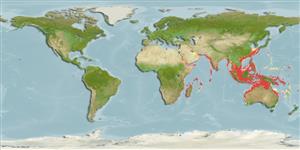Common names from other countries
>
Tetraodontiformes (Puffers and filefishes) >
Diodontidae (Porcupinefishes (burrfishes))
Etymology: Cyclichthys: Greek, kyklos = round + Greek, ichthys = fish (Ref. 45335).
More on author: Bloch.
Environment: milieu / climate zone / depth range / distribution range
Écologie
marin récifal; profondeur 9 - 170 m (Ref. 30573). Tropical; 32°N - 36°S, 24°E - 168°E
Indo-West Pacific: Red Sea and East Africa to the Philippines, north to southern Japan, south to Australia and New Caledonia (Ref. 9680). Southeast Atlantic: south coast of South Africa (Ref. 4423).
Taille / Poids / Âge
Maturity: Lm ? range ? - ? cm
Max length : 30.0 cm TL mâle / non sexé; (Ref. 9710)
Description synthétique
Morphologie | Morphométrie
Épines dorsales (Total): 0; Rayons mous dorsaux (Total): 11-13; Épines anales 0; Rayons mous anaux: 10 - 12. Adults brown to grey with blotches and clusters of black spots on back and sides; pelagic juveniles covered with black spots (Ref. 4423).
Inhabit clear protected reefs with sponge and algal habitats. Often in large sponges during the day (Ref. 48637). Usually over sand and mud bottoms to at least 170 m (Ref. 30573). Occasionally on reefs (Ref. 9680). Active at night, feeding among reefs (Ref. 48637). A nocturnal species (Ref. 9710) that presumably feeds on hard-shelled invertebrates (Ref. 9680, 48637).
Life cycle and mating behavior
Maturité | Reproduction | Frai | Œufs | Fécondité | Larves
Randall, J.E., G.R. Allen and R.C. Steene, 1990. Fishes of the Great Barrier Reef and Coral Sea. University of Hawaii Press, Honolulu, Hawaii. 506 p. (Ref. 2334)
Statut dans la liste rouge de l'IUCN (Ref. 130435)
CITES (Ref. 128078)
Not Evaluated
Menace pour l'homme
Harmless
Utilisations par l'homme
Pêcheries: pêcheries vivrières; pêche sportive: oui
Plus d'informations
Noms communsSynonymesMétabolismePrédateursÉcotoxicologieReproductionMaturitéFraiFéconditéŒufsDéveloppement de l'œuf
RéférencesAquacultureProfil d'aquacultureSouchesGénétiqueElectrophoresesHéritabilitéPathologiesTraitementMass conversion
Outils
Articles particuliers
Télécharger en XML
Sources Internet
Estimates based on models
Preferred temperature (Ref.
115969): 22.3 - 28.3, mean 26.8 (based on 908 cells).
Phylogenetic diversity index (Ref.
82804): PD
50 = 0.6250 [Uniqueness, from 0.5 = low to 2.0 = high].
Bayesian length-weight: a=0.04786 (0.01967 - 0.11644), b=2.82 (2.61 - 3.03), in cm Total Length, based on LWR estimates for this (Sub)family-body shape (Ref.
93245).
Niveau trophique (Ref.
69278): 3.6 ±0.59 se; based on food items.
Résilience (Ref.
120179): Haut, temps minimum de doublement de population inférieur à 15 mois (Preliminary K or Fecundity.).
Fishing Vulnerability (Ref.
59153): Low vulnerability (20 of 100).
